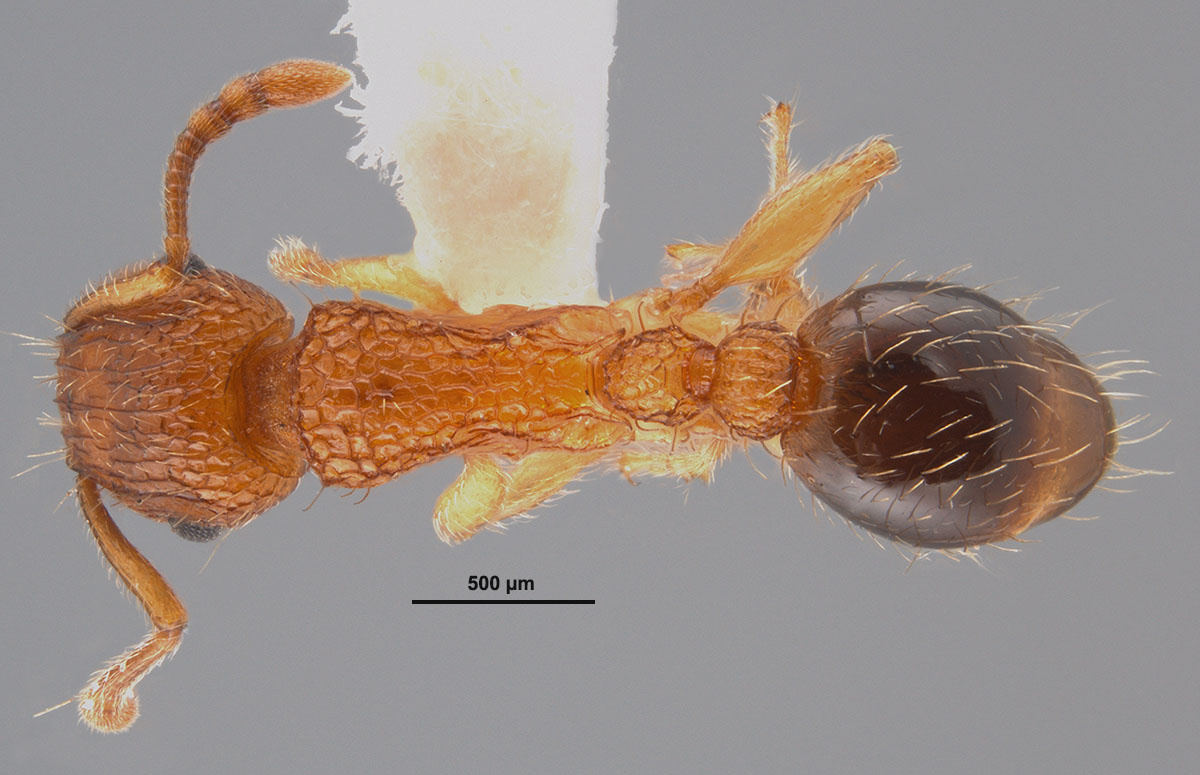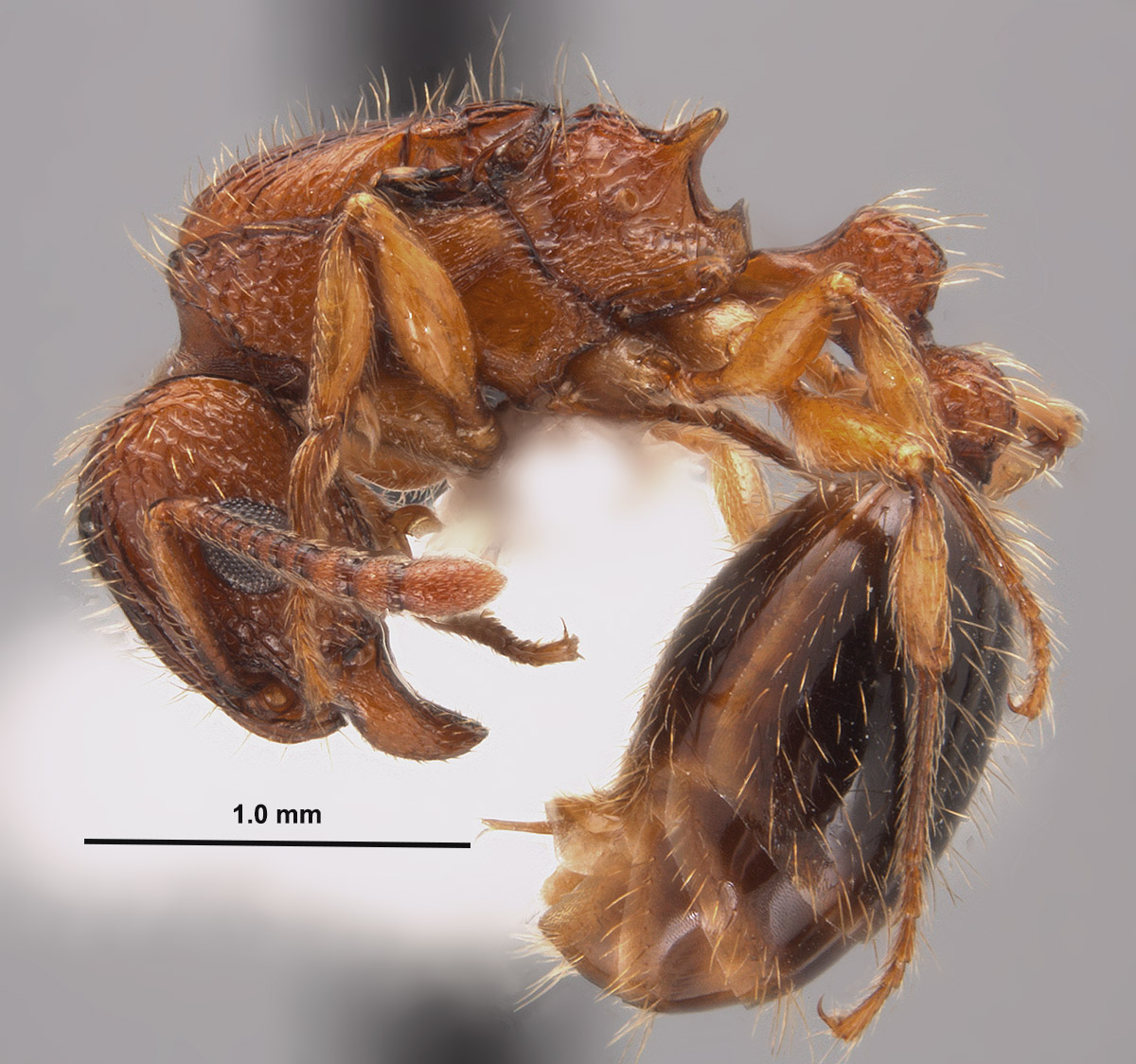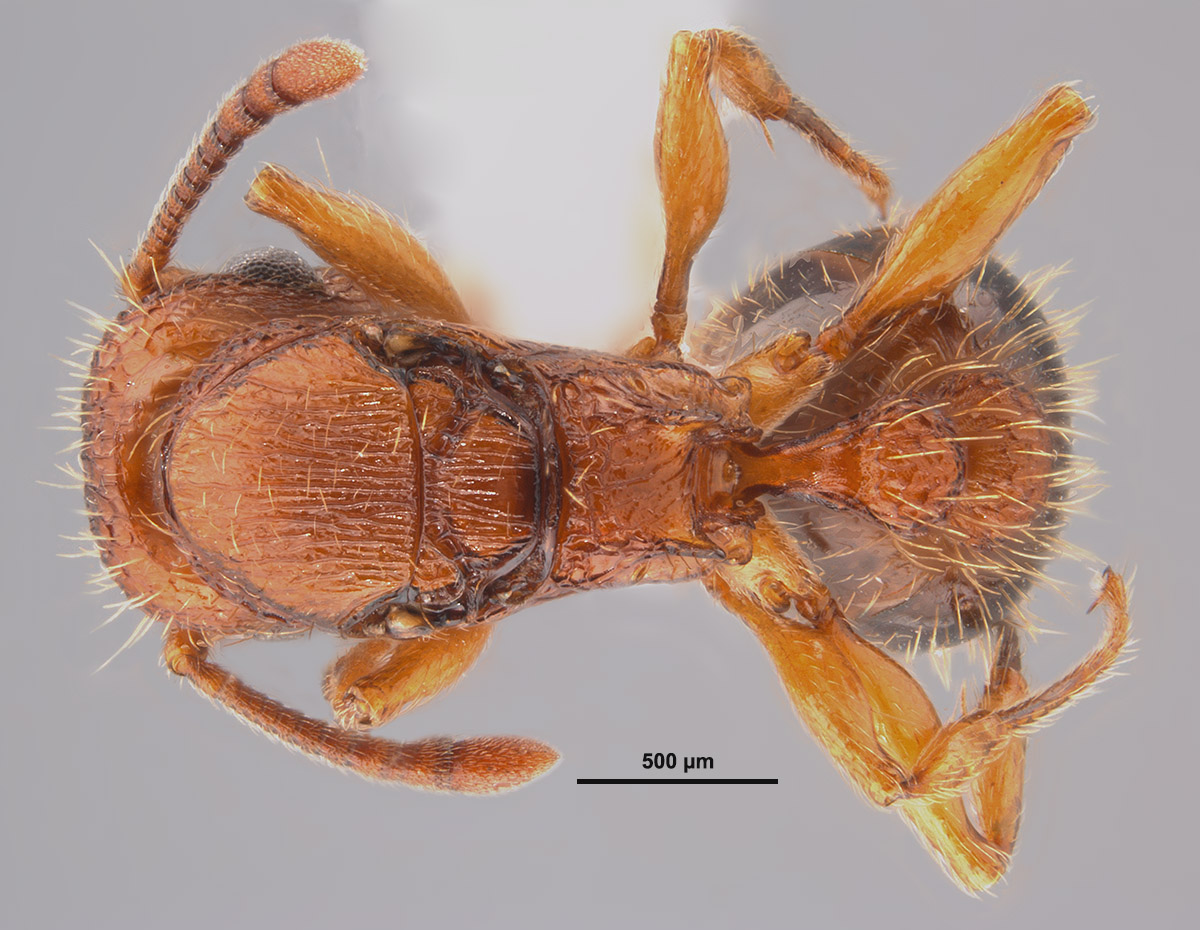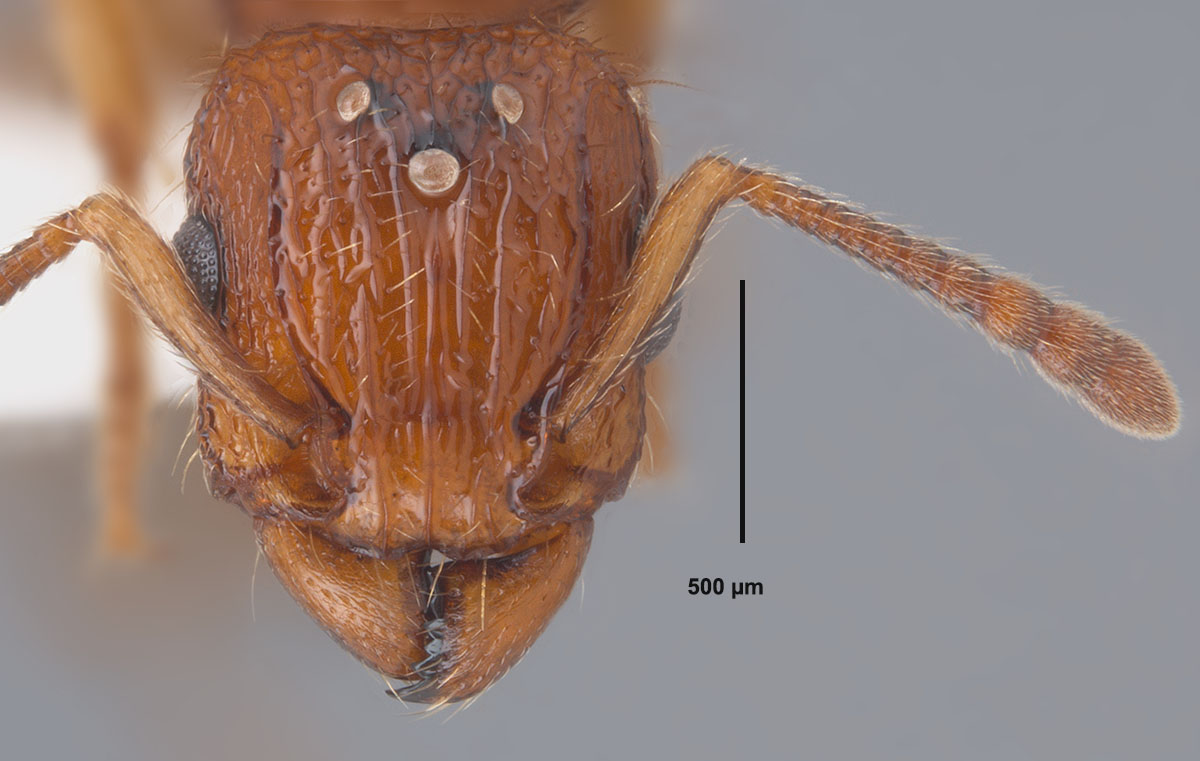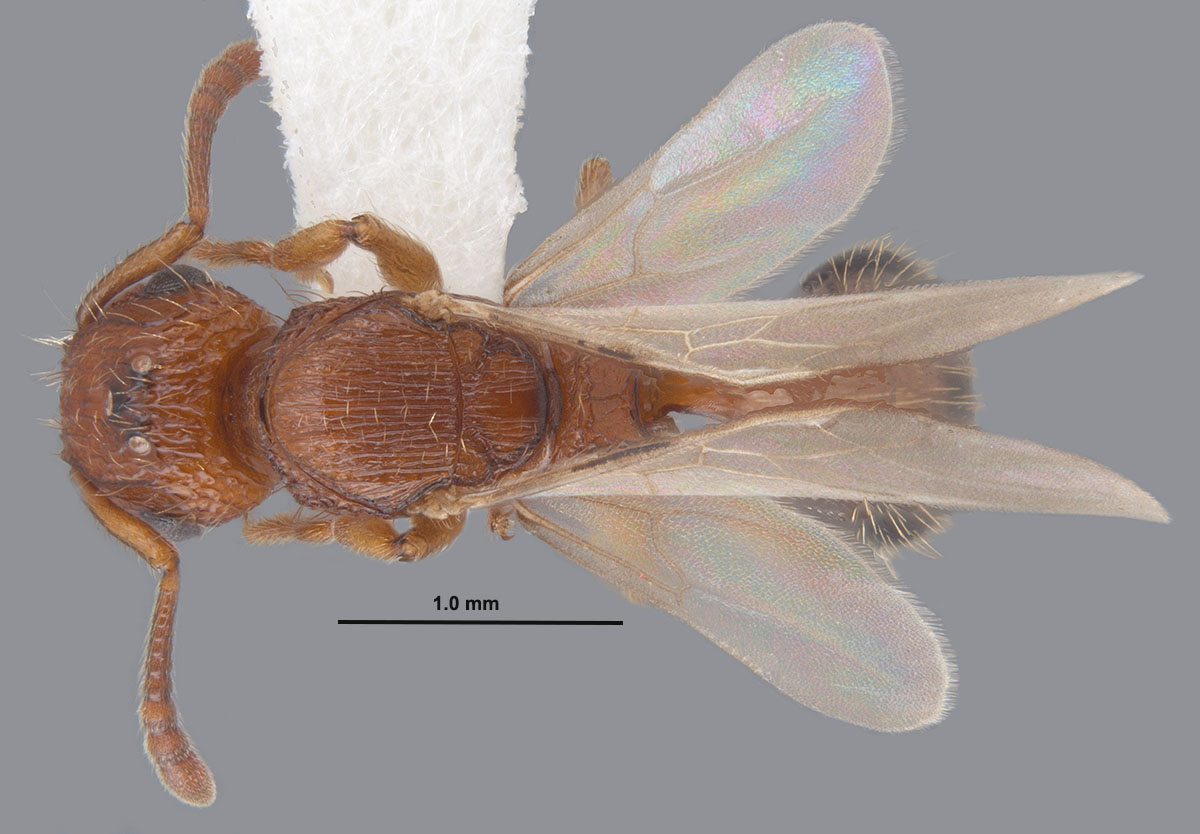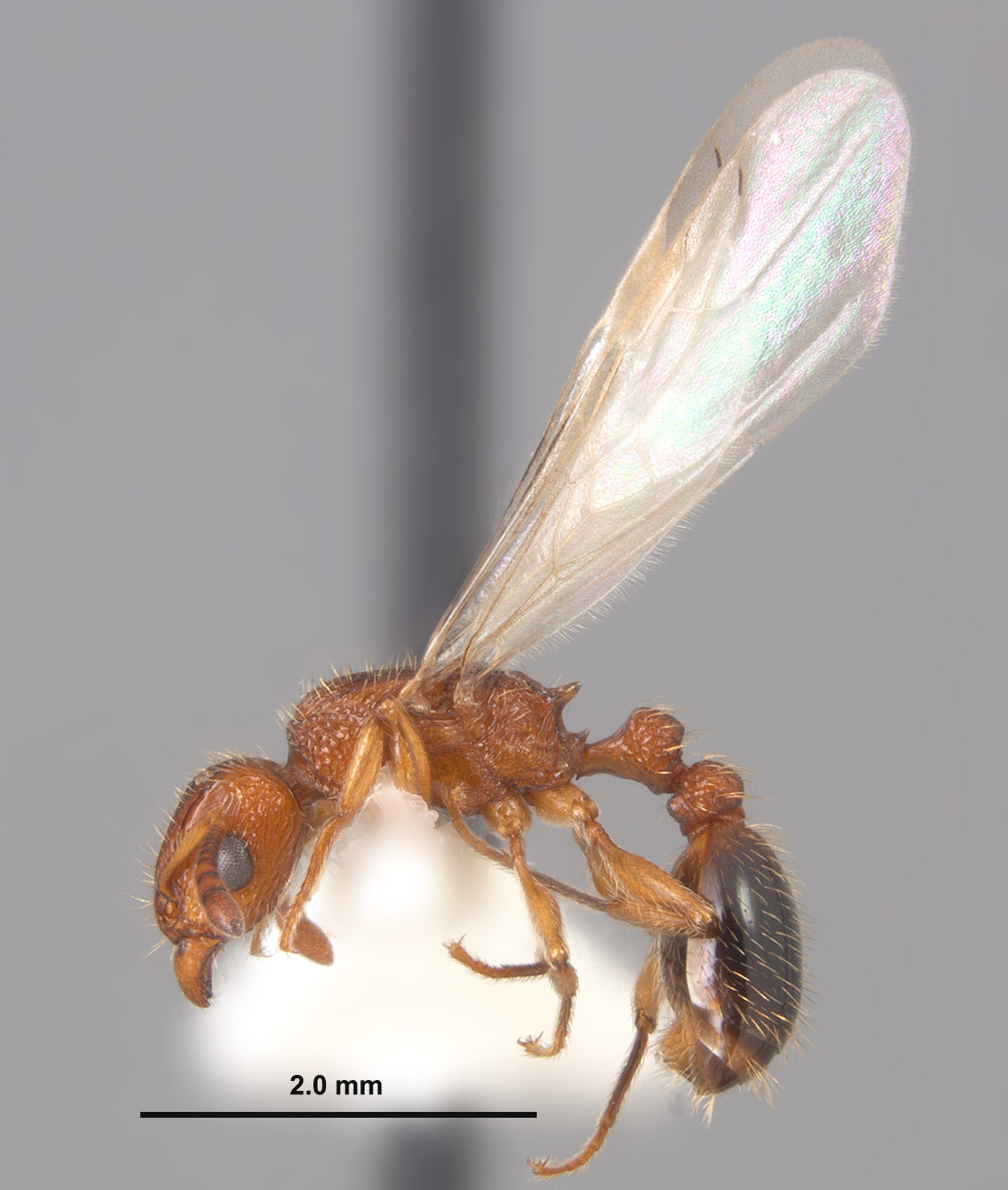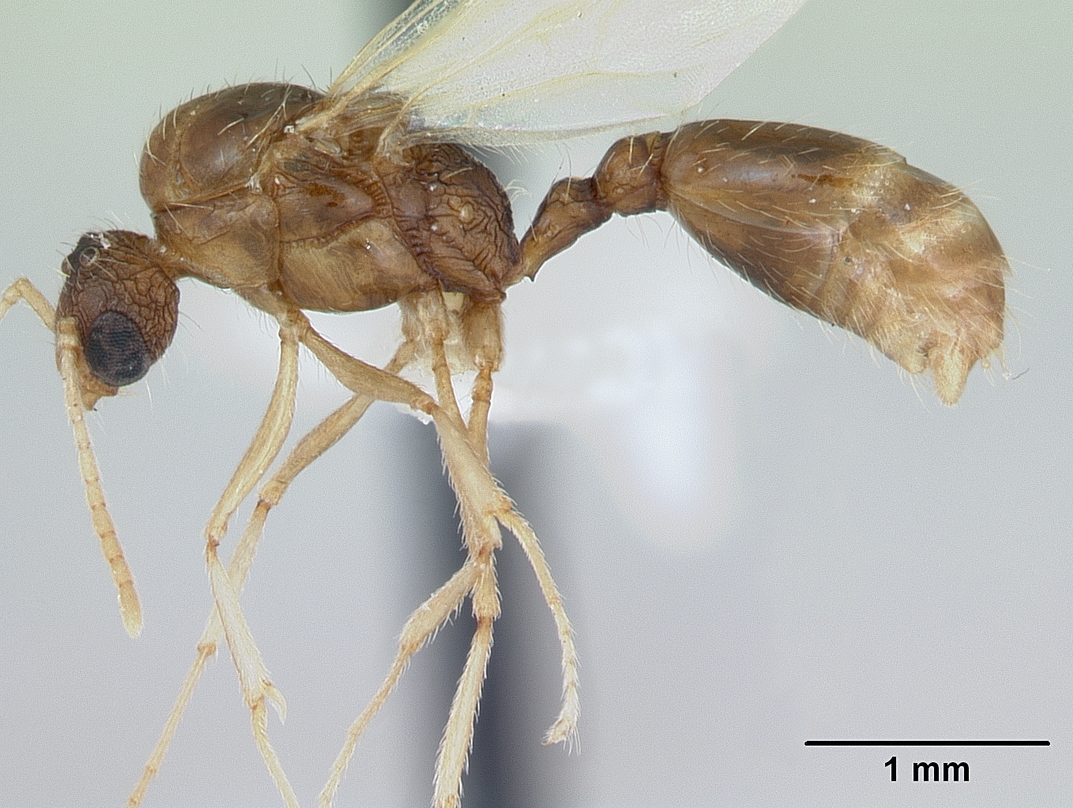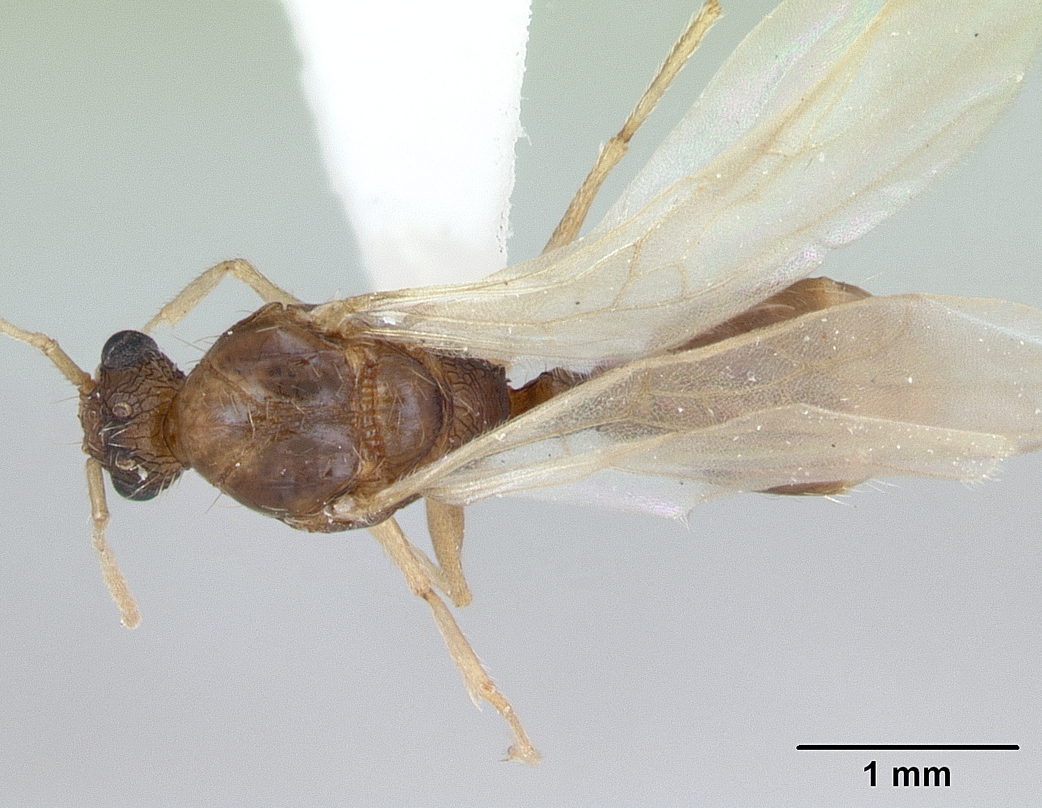Subfamily MYRMICINAE Bicolored pavement ant Authors: Joe A. MacGown and Ryan J. Whitehouse |
||
Tetramorium bicarinatum, full face view of worker (MS, Jackson Co.) (photo by Joe A. MacGown)
|
Tetramorium bicarinatum, lateral view of worker (MS, Jackson Co.) (photo by Joe A. MacGown) |
Tetramorium bicarinatum, lateral view of worker (MS, Jackson Co.) (photo by Joe A. MacGown) |
Tetramorium bicarinatum, full face view of worker (MS, Pearl River Co.) (photo by Ryan J. Whitehouse and Joe A. MacGown) |
Tetramorium bicarinatum, lateral view of worker (MS, Pearl River Co.) (photo by Ryan J. Whitehouse and Joe A. MacGown) |
Tetramorium bicarinatum, dorsal view of worker (MS, Pearl River Co.) (photo by Ryan J. Whitehouse and Joe A. MacGown) |
Tetramorium bicarinatum, full face view of dealate queen (CA, Los Angeles Co.) (photo by Ryan J. Whitehouse and Joe A. MacGown) |
Tetramorium bicarinatum, lateral view of dealate queen (CA, Los Angeles Co.) (photo by Ryan J. Whitehouse and Joe A. MacGown) |
Tetramorium bicarinatum, dorsal view of dealate queen (CA, Los Angeles Co.) (photo by Ryan J. Whitehouse and Joe A. MacGown) |
Tetramorium bicarinatum, full face view of alate queen (MS, Pearl River Co.) (photo by Ryan J. Whitehouse and Joe A. MacGown) |
Tetramorium bicarinatum, lateral view of alate queen (MS, Pearl River Co.) (photo by Ryan J. Whitehouse and Joe A. MacGown) |
Tetramorium bicarinatum, dorsal view of alate queen (MS, Pearl River Co.) (photo by Ryan J. Whitehouse and Joe A. MacGown) |
Tetramorium bicarinatum, dorsal view of alate queen (MS, Pearl River Co.) (photo by Ryan J. Whitehouse and Joe A. MacGown) |
||
Tetramorium bicarinatum, full face view of male (CA, Los Angeles Co.) (photo by AntWeb.org) |
Tetramorium bicarinatum, lateral view of male (CA, Los Angeles Co.) (photo by AntWeb.org) |
Tetramorium bicarinatum, dorsal view of male(CA, Los Angeles Co.) (photo by AntWeb.org) |
Introduction Tetramorium species can be identified separated from other myrmicine spines but the combination of the following characteristics: lateral part of the clypeus forming a sharp wall anterior to the antennal insertion; frons; 11 or 12-segmented antennae with three-segmented antennal club; antennal scrobe present from antennal insertion point to the posterior corner of head; two segmented waist; sting with a lamellate appendage found apicodorsally that projects at an angle to the long axis of the sting shaft. Tetramorium bicarinatum is distributed worldwide and is one of the most abundant species of Tetramorium. It is known to occur in tropical and subtropical climates and has been found in heated buildings in more temperate areas. Historically this species was misidentified as T. guineese (Fabricius, 1793). Taxonomic History Diagnosis Identification Queen: Slightly larger than worker (HL 1.07–1.12mm, HW 0.92–0.95 mm, SL 0.66–0.69 mm, EL 0.28–0.30 mm, MeSL 1.45–1.51 mm) (n=5) (MEM specimens). Head, mesosoma, and waist orange reddish brown; legs light, orangish brown; and gaster dark brown. Head rounded rectangular, but widest posteriorly; strongly shining, with medial, longitudinal rugae extending from clypeus towards the posterior border, strong rugoreticulation present on posterior region of head (in full face view) and on sides of head; numerous erect setae present; eyes well developed, located along the midline of the head; three whitish colored ocelli present; lateral portions of clypeus forming a sharp wall anterior to antennal insertion point; antennae 12-segmented with a three-segmented club; scape fits against head along a longitudinal ridge running from the posterior side of the clypeus to the posterior border of the head; clypeus notched or indented along the anterior border; mandibles triangular. Mesosoma elongate, rounded rectangular, shiny; pronotum and propodeum with strong rugoreticulation; mesoscutellum and mesoscutum with longitudinal rugae; anepisternum with transverse rugae, katepisternum mostly lacking sculpture except at edges; numerous simple, erect setae present on mesosomal dorsum; dorsal surface flat with a distinct notch at the propodeal suture; propodeal spines bidentate with the length of each dorsal spine about twice the length of the each ventral spine; mesosoma enlarged with four wings or wing scars. Wings hyaline, with typical myrmicine venation; forewing with pale stigma, closed elongate costal cell, basal cell, marginal cell, submarginal cell, discal cell, and subbasal cell; medial vein almost reaches wing tip; hindwing lacking jugal lobe and with costal, basal, and subbasal cells closed. Waist two-segmented, both nodes with strong reticulation; conspicuous, posteriorly directed, erect setae present; petiolar node and postpetiolar node subequal in length: petiole with a short tooth present anteroventrally, tooth directed slightly anteriorly. Gaster shining with conspicuous, erect setae; first tergite makes up at least half of length; sting present and with a lamellate appendage found apicodorsally that projects at an angle to the long axis of the sting shaft. Male: Small (based on antweb.org photos). Head fading from yellowish brown anteriorly to brown posteriorly, mesosoma, waist, and gaster grown with lighter yellowish brown coloration at posterior edges of gastral segments; antennae and legs pale yellow brown. Head somewhat cirular in full face view, longitudinal rugae present medially, extending from anterior portion of clypeus to base of lower ocellus, remainder of head with strong, deep, rugureticulation, with fine punctulation present in spaces formed between; numerous erect setae present of various lengths, most of the setae on posterior border longer than those on the face; eyes large, about half the length of the head; three large, whitish colored ocelli present, slightly raised; mandibles triangular with elongate apical tooth followed by four smaller teeth; anterior clypeal border relatively straight; antennae ten-segmented; scape and second funicular segment subequal in length. Mesosoma ovoid in lateral view, slightly matte in appearance; mesoscutum, mesoscutellum, pronotum, and mesopleura lacking sculpture except for transverve striae in sulcus; prododeum with loose, well defined rugoreticulation and transverse rugae at edges; scattered semi erect setae present, especially dorsally; mesoscutum enlarged, smoothly curved and overhanging propodeum; wings transparent; with similar venation to female, except pterostigma in forewing mostly transparent; propodeum rounded posteriorly, spines lacking. Waist two-segmented, with loose rugoreticulation present and scattered, posteriorly directed, erect setae; petiole elongate, longer than postpetiole, with a small sharp subpetiolar process present anteroventrally, directed anteriorly; postpetiole somewhat circular in dorsal view. Gaster lacking obvious sculpture, with conspicuous, erect setae directed posteriorly; first tergite darker than the remaining ones; genitalia visible at the apex, in side view parameres triangular, rounded apically. Biology Pest Status Distribution Native Range: Southeast Asia (Bolton, 1977, 1979, 1980). Australian: American Samoa, Australia, Federated States of Micronesia, Fiji, French Polynesia, Guam, Hawaii, Indonesia, Kiribati, Lord Howe Island, Marshall Islands, New Caledonia, New Guinea, New Zealand, Niue, Norfolk Island, Samoa, Solomon Islands, Tokelau, Tonga, Vanuatu (AntWeb.org and AntWiki.org). U.S. Distribution: AL, AR, CA, FL, GA, HI, IL, LA, MS, MO, NC, SC, TX (AntWeb.org and MEM). Acknowledgments Literature Cited Bolton, B. 1979. The ant tribe Tetramoriini (Hymenoptera: Formicidae). The genus Tetramorium Mayr in the Malagasy region and in the New World. Bulletin of the British Museum (Natural History). Entomology 38:129-181. Bolton, B. 1980. The ant tribe Tetramoriini (Hymenoptera: Formicidae). The genus Tetramorium Mayr in the Ethiopian zoogeographical region. Bull. Br. Mus. (Nat. Hist.) Entomol. 40: 193-384 Donisthorpe, H. 1932. On the identity of Smith's types of Formicidae (Hymenoptera) collected by Alfred Russell Wallace in the Malay Archipelago, with descriptions of two new species. Annals and Magazine of Natural History (10)10:441-476. Fabricius, J. C. 1793. Entomologia systematica emendata et aucta. Secundum classes, ordines, genera, species, adjectis synonimis, locis observationibus, descriptionibus. Tome 2. Hafniae [= Copenhagen]: C. G. Proft, 519 pp. Forel, A. 1891. Les Formicides. [part]. In: Grandidier, A. 1891. Histoire physique, naturelle, et politique de Madagascar. Volume XX. Histoire naturelle des Hyménoptères. Deuxième partie (28e fascicule). Paris: Hachette et Cie, v + 237 pp. Hita Garcia, F.; Fisher, B. L. 2011. The ant genus Tetramorium Mayr (Hymenoptera: Formicidae) in the Malagasy region—introduction, definition of species groups, and revision of the T. bicarinatum, T. obesum, T. sericeiventre and T. tosii species groups. Zootaxa 3039:1-72. Mayr, G. 1862. Myrmecologische Studien. Verhandlungen der Kaiserlich-Königlichen Zoologisch-Botanischen Gesellschaft in Wien 12:649-776. Nylander, W. 1846. Additamentum adnotationum in monographiam formicarum borealium Europae. Acta Societatis Scientiarum Fennicae 2:1041-1062. Roger, J. 1862. Synonymische Bemerkungen. 1. Ueber Formiciden. Berliner Entomologische Zeitschrift 6:283-297 Smith, M.R. 1965. House-infesting ants of the Eastern United States, Their Recognition, Biology, and Economic Importance. Agricultural Research Service, United States Department of Agriculture Technical Bulletin No. 1326. Wheeler, W. M. 1924. A gynandromorph of Tetramorium guineense Fabr. Psyche (Cambridge) 31:136-137. Wheeler, G. C.; Wheeler, J. 1954. The ant larvae of the myrmicine tribes Meranoplini, Ochetomyrmicini and Tetramoriini. American Midland Naturalist 52:443-452. Links |
||







